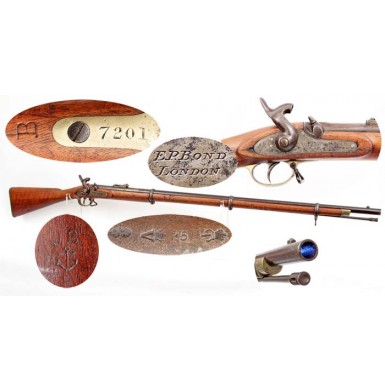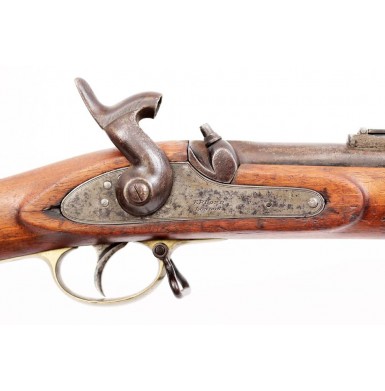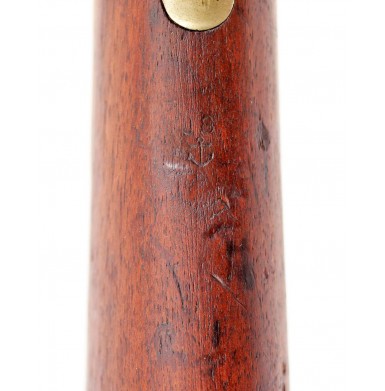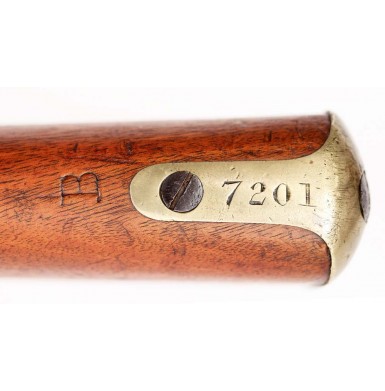Confederate JS/Anchor Marked & Numbered Enfield Rifle Musket
- Product Code: FLA-2781-SOLD
- Availability: Out Of Stock
-
$0.00
The most iconic of the imported arms to see service with the Confederacy during the American Civil War is the British P-1853 Enfield Rifle Musket, marked with the Confederate J S / Anchor viewer’s mark of John Southgate, combined with an engraved Confederate inventory number on the tang of the brass buttplate. If a collector were to have only one true Confederate imported weapon in their collection, one of these Confederate marked Enfields would be the perfect addition. There is no more striking image than that of the ragged Confederate infantryman with a P-1853 Enfield Rifle Musket in his hands, doggedly defending his belief in states rights and defending his boarders from the perceived Northern invasion.
During the early days of the American Civil War, Confederate purchasing agents did a splendid job of tying up contracts for the British P-1853 Enfield Rifle Musket, which was truly one of the most advanced and well made long arms of the day. According to Confederate Chief of Ordnance, Josiah Gorgas’s February 3, 1863 summary of imported arms, some 70,980 “Long Enfield Rifles” were purchased from the beginning of the war through the end of 1862. These numbers only account for Confederate central government purchases, and do not include those P-1853s purchased by the individual Confederate states or by speculators seeking to sell them within the Confederacy. The majority of these arms were purchased from the firms of S. Isaac, Campbell & Company (who relied on John Edward Barnett & Sons to deliver many of those arms) or Sinclair, Hamilton & Company, who often routed their sales through S. Isaac, Campbell & Co as well. Additional P-1853s were purchased from William Grazebrook of Liverpool, who made his first sales to Confederate purchasing agent Caleb Huse within 30 days of the opening of the war. Sinclair, Hamilton & Company entered into several contracts with the Confederacy to deliver P-1853 Enfield Rifle Muskets, with the typical contract terms requiring 30,000 arms to be delivered over a six month period. During the course of the war, Sinclair, Hamilton & Company appear to have received as many as five of these contracts for P-1853 Enfield Rifle Muskets from the Confederate central government. The second of these contracts for 30,000 P-1853 “long Enfields’ is the one represented by the guns with the JS / (ANCHOR) mark, along with the engraved buttplate tang inventory numbers. These inventory numbers ran from 1-10,000 in three series (to date no gun with a 10,000 number is known, although theoretically they existed). The first series had no suffix after the number, while the second series of 10,000 had an “A” suffix under the inventory number and the third series of 10,000 had a “B” suffix. These numbered guns represent the October 1861 contract with Sinclair, Hamilton & Company that is referred to in Confederate documents as the “Second Contract”. This contract required the 30,000 Enfields to be delivered between October of 1861 and April of 1862. At least two identified “B” suffix numbered guns have been determined to have been issued in Corinth, MS immediately prior to the battle of Shiloh on April 6-7 of 1862. Thus is it clear that the contract time line for production and delivery was closely followed. Sinclair, Hamilton & Company acquired their arms through “Five Furnishers”. These companies were able to fill the large Sinclair, Hamilton & Company orders in a reasonable period of time. The “five furnishers’ were the long time London gunmakers EP Bond and Parker, Field & Co, with James Kerr apparently receiving a tiny portion of the contract (only 500 guns) due to his relationship with the London Armoury Company, which was managed by Archibald Hamilton of Sinclair, Hamilton & Company. The balance of the guns were delivered by the Birmingham based firms of CW James and W.C. Scott & Son. The furnishers often marked the guns that were delivered under the contract with a large single letter on the upper comb of the stock. The guns were marked with a B for Bond, an F for Parker, Field & Co, a J for James, a K for Kerr and an S for Scott & Son. An October 31, 1861 dated letter from Sinclair, Hamilton & Co. notes that the contract was divided between the furnishers as follows: 8,000 guns from Scott & Son, 10,000 from CW James, 6,000 from E.P. Bond, 5,500 from Parker, Field & Co and 500 from James Kerr. This indicates that the guns delivered by Scott & Son represented about “ of the total delivery under this contract. An extensive database comprised of more than two decades of collected information related to Confederate purchased Enfields contains approximately 250 numbered P-1853 Enfield rifle muskets (not counting state purchased guns). Of those guns, the large majority (well more than half) are numbered guns with no suffix, representing about 74% of the recorded samples. A-suffix guns represent about 19% of the recorded examples, while B-suffix guns represent about 7% of surviving examples that are recorded. To date, less than 50 A-suffix and less than 20 B-suffix P-1853 Enfields are known to exist. The reason for the paucity of these arms is not clear, but it may simply be the result of attrition and the arms having been used up. With B-suffix guns, the lack of extant examples appears to be an indication of the early successes experienced by the Union’s Atlantic Blockading Squadron. Recorded numbers show a good distribution of engraved numbers from two digits through the mid 2XXX range. Then there is then a nearly 4,000 number gap in the database that seems to indicate that a large number of the “B-guns’ in the 25XX to 62XX range may well be on the bottom of the Atlantic ocean. “A suffix” guns, although uncommon and with few examples to study, shows a nice even distribution through the entire numbering sequence. This suggests that their scarcity today is the result of them having seen hard use, rather than having been dumped overboard while a Confederate blockade runner tried to elude a pursuing US Naval vessel.
The P-1853 Enfield Rifle Musket offered here is a classic example of a Confederate marked and imported musket that clearly saw use in the field and shows some real battlefield damage, suggesting one of the reasons that these guns are so scarce today. The gun is in about VERY GOOD condition and is marked in the wood behind the trigger guard with the classic J S / (ANCHOR) mark. The buttplate tang is engraved with the inventory number 7201, indicating that this gun was in the first group of 10,000 muskets to be delivered under the 2nd Sinclair, Hamilton & Company contract. The gun is marked with a large B on the upper comb of the stock, indicating that E.P. Bond of London was the furnisher of the gun. The firm of Edward Philip Bond was one of the larger London gunmaking companies, which could trace their roots in the gun making business to the early 1700’s, when the first Bond of the family was “Freed of the Gunmakers Company” (released from apprenticeship as a “master” gunmaker) in 1730. Over the next hundred years the family flourished in the gun trade, and in 1835 Edward Philip Bond was apprenticed to his uncle William Thomas Bond. In 1836, Edward was turned over to John Edward Barnett to continue his apprenticeship and was free of the Gunmakers Company in 1842. The time Bond spent apprenticed to Barnett no doubt established the long time relationship between the two companies that continued well into the American Civil War era, as both firms became major suppliers of arms to the Confederacy.
The lock of the gun is marked E.P. BOND / LONDON forward of the lock, without the usual British “Crown” to the rear of the hammer. The gun bears no British military marks at all, which is typical of guns bound for export markets. The upper left of the breech is marked with the usual London commercial View, Proof and Definitive Proof marks, and with a single 25 gauge mark, indicating .577 caliber. The interior of the lock bears few marks other than the initials B and E.B. over the mainspring, indicating assembly by E.P. Bond. There is also a single W mark, that may be that of the lock maker or the setter-up, who actually assembled the gun. The bottom of the barrel is marked with the marks O 231 JC4, as well as a Belgian intertwined, script EL, indicating the rough gun barrel was manufactured in Li’ge, Belgium. The initials J.W. are also present on the bottom of the barrel, again these are likely the initials of the “setter up”. The interior of the barrel channel of the stock has an old, penciled name & location that reads L F St.Amand “ Charleston, SC. An additional, semi-legible word is present as well that appears to read “Cainhoy”, which I do not recognize. A search of multiple Civil War databases reveals only a single “L. St.Amand”, who served as a Lieutenant in Company G of the 1st Regiment, 2nd Battalion, 1st Division of the Louisiana Militia. The only “L.F. St.Amand” that I could find in the era who was from Charleston, SC was only 5 years old when he was listed in the 1860 Census. His father was listed in the Census as an “A. St.Amand”, and an “A.W. St.Amand” did serve the state of South Carolina during the Civil War in the Palmetto Sharp Shooters. This gun may have been carried by “L.F.’s” father and given to his son after the war. The gun is certainly worthy of additional research.
As previously noted, the overall condition of the gun is about VERY GOOD, and for a Confederate used and carried rifle musket that probably arrived in the south sometime prior to mid-1862, it is really in very nice shape, even considering the battle damage to the stock. The exposed metal of the gun has a mostly smooth plum brown patina, mixed with gray gunmetal over most of the barrel. Amazingly, the metal is mostly smooth; with some only some light to moderate surface oxidation, and some scattered peppering and minor pinpricking forward of the rear sight. As would be expected, the breech and bolster area do show light flash pitting, which is expected from a combat used percussion rifle musket. The bore of the musket is in about GOOD+ to NEAR VERY GOOD condition. The bore of the gun is mostly dark, with a seasoned appearance and retains strong 3-groove, progressive depth rifling. The bore shows light pitting along its entire length, with some scattered patches of more moderate and even some heavy pitting, most of which is present from the middle of the barrel forward towards the muzzle. The action of the gun is mechanically excellent and functions crisply on all positions. The brass furniture has a medium golden patina, which is very attractive. The original long-range rear sight is present, and is complete and fully functional. The front sight/bayonet lug is present near the muzzle as well. Both original sling swivels remain with the gun as well. The three original Palmer pattern clamping barrel bands all retain their tension screws and original doughnut-like keepers at their ends. The original ramrod, which was numbered to the gun, is missing in action. This is typical with numbered Enfields, as less than 10% of extant examples retain a numbered ramrod (let alone the original matching one). The ramrod that now accompanies the gun is an original, P-1853 ramrod from the period, which is full length and retains its original threads at the end. The stock is in about GOOD+ to NEAR VERY GOOD condition as well, but shows some original battle damage that thankfully no one has tried to repair. The stock shows a significant number of rather deep dents, dings and divots in the area between the middle and upper barrel band, most of which is under the stock along the rammer channel. This is clearly depicted in the pictures of the gun below. It is not clear if this is from rough handling, dropping the gun or possibly due to some minor shrapnel strikes. The stock also shows a few minor hairline cracks, which remain stable and seem to be non-structural. One runs from the nose cap, back towards the upper barrel band and may be related to the impacts that caused the stock damage noted above. The other is a short, tight, grain crack that runs from the tail of the lock towards the wrist. As noted, both are tight grain cracks and appear stable. The stock bears the expected JS / (ANCHOR) inspection mark in the wood behind the triggerguard. The mark is fairly crisp and quite legible. As noted earlier, a crisp B furnishers mark is present on the top of the comb of the stock. The block letter mark A.R.is stamped at the tail of the flat, opposite the lock. This is probably the mark of the gun’s “stocker” or possibly the “setter up”. The stock is solid and complete, and other than the battle damage noted above, shows no abuse. The stock does show the numerous bumps and dings from field service, as would be expected. The stock shows some rounding of sharp edges and lines, but this most likely from carry, use and wear with and possibly an old cleaning. The legible and mostly crisp “JS/Anchor” and “AR” marks suggest the stock has not been sanded. The stock is solid and full length, and even the damaged area should not deteriorate further as long as the gun is not abused or subjected to significant stress. The damage is only partially visible when the gun is displayed on a wall, and does not detract from display as it shows real field service damage to a Confederate marked Enfield. There appears to be a name or set of initials lightly scratched into the obverse buttstock, but these letters are illegible.
Overall, this is really cool example of a completely authentic Confederate imported and used Enfield Rifle Musket that not only saw field service, but was also wounded in action. The gun has the most desirable and well known of Confederate import marks, a wonderful JS / (ANCHOR). It also has a great engraved inventory number, and a crisp furnisher’s mark. This gun was clearly a fairly early arrival in the Confederacy that was likely on the field before the beginning of the 1862 spring and summer campaign seasons. The condition clearly shows that this gun saw service and fought hard for Southern independence during the course of the war. Somehow, through all of that hard use and combat damage, the gun managed to survive in very nice, complete condition. This was not a gun that went home as a war trophy during the early days, or that was captured on a blockade-runner and later sold as surplus. This gun fought the war for the Confederate cause and is one of those weapons that you wish could tell you its story. With only 1 in 5 JS / (ANCHOR) marked long Enfields having been delivered by E.P Bond, and with less than 1% of those 30,000 guns having survived to be in collections today, this is simply an incredibly scarce example of a Confederate purchased gun. If you have ever wanted to own a completely correct and honest Confederate used P-1853 Enfield Rifle Musket, that really saw service and fought the war, this would be a great addition to you collection. This gun is an iconic piece of history, which was no doubt a witness to some of the most horrific moments in the American Civil War.
SOLDTags: Confederate, JS, Anchor, Marked, Numbered, Enfield, Rifle, Musket,







